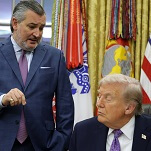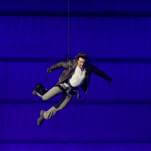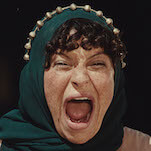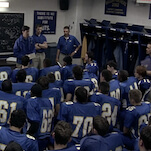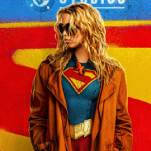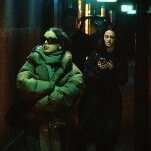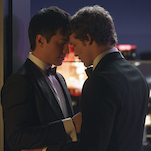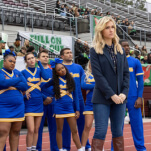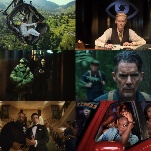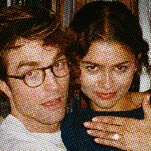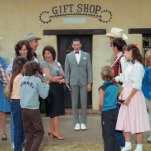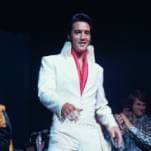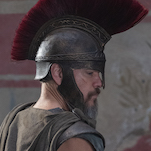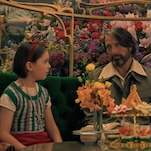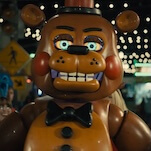Imagine that you’re at the multiplex to see your favorite actor’s latest star vehicle. Doesn’t really matter who it is, but for the purposes of this exercise, let’s stipulate that it’s somebody very famous, a take-charge personality. Liam Neeson would be perfect, but it could be Matt Damon, Denzel Washington, Daniel Day-Lewis, whoever. Anyway, he’s playing the leader of a gang or a criminal organization of some kind, and early scenes show him planning a big heist. Maybe he and his confederates have noble motives for the robbery. Not important. What is important is that you came to see Neeson (or Damon, or whoever) do his badass thing… but his character is shot during the holdup, badly wounded, abandoned by the rest of the gang. He’s bleeding so much, he can barely stay conscious. And while he’s physically present for much of what follows, it’s only in the way that, say, Tim Roth is physically present for the first half of Reservoir Dogs. The actual movie is about the various people who come in contact with him, virtually none of whom are played by similarly well-known actors.
Sound plausible? That’s the gist of Carol Reed’s 1947 classic Odd Man Out, which stars James Mason—the most popular British actor for four years running at the time of its release—as IRA leader Johnny McQueen. (His group is called “The Organization” throughout, but it’s Northern Ireland, so who are we kidding?) Mason gets shot 14 minutes into the two-hour picture, and is only intermittently awake and coherent from that point forward; the drama revolves entirely around random citizens, mostly embodied by stage actors Reed drafted from the Abbey Theatre in Dublin. It’s a portrait of a community, exploring the ambivalence of people who sympathize with Mason’s cause, but not necessarily with his methods. In its finest, thorniest scene, a couple of middle-aged women gradually realize that the “accident victim” they’ve taken in won’t likely garner them awards for Samaritans Of The Year. It’s too long to excerpt in its entirety, but take a look at the first few minutes, up to the point where the light dawns.
Reed makes a peculiar and interesting choice right at the outset, as the “accident” occurs. It’s been well established by this point in the film (about 40 minutes in) that Mason is extremely weak, and it’s clear that the lorry doesn’t actually hit him—he just stumbles backward a bit, then sinks to the ground from sheer exhaustion. But the idea is that the two ladies, from their vantage point across the road, think they see him get sideswiped. From their point of view, the geometry makes sense. (Though it’s tough to see precisely where they’re meant to be, as they aren’t visible beyond Mason until they go running toward him.) It would look to them like a hit-and-run. Thing is, though, viewers have to perform that act of mental projection, because Reed doesn’t provide a shot from the women’s point of view. Instead, he offers two shots from the lorry driver’s point of view, emphasizing not the illusion that Mason’s been hit—ostensibly the point—but the danger that he’s going to be hit. Reed lets the dialogue do the dirty work (“He’s hit him!”) in order to visually underline the film’s central concern: Mason’s fate is in the hands of ordinary working folk, who may or may not choose to swerve in time.
Once the women get him inside, the scene takes a turn that seems quintessentially British. Both Maureen (Ann Clery) and Maudie (Beryl Measor) are right proud of the first-aid techniques they learned in the ARP, which stands for Air Raid Precautions. Mason collapses into a chair and the ladies start squabbling over the nature of Mason’s injury, over who knows better what steps ought to be taken (“You know darn well you failed in your practicals”), over the ethics of cutting up somebody’s clothes without first asking permission, and so forth. This sort of light-comic duo was a staple of British cinema at the time, dating back (at least) to the cricket-obsessed Charters and Caldicott in Alfred Hitchcock’s The Lady Vanishes; occasionally, as in that film, such characters would even get involved in the action. But the abrupt shift here from jocular needling to grave concern serves a different function entirely. I especially love the way Maureen, the more assertive of the two, responds to her first sight of the gunshot wound by unconsciously fondling her wedding ring, as if already thinking of what will happen when her husband arrives. (He shows up right after this clip ends, and ultimately allows Mason to head out on his own.)
Note that even after they see the bullet hole in Mason’s arm, the women continue as long as they can with the pretense that his injury was caused by the truck. “I shouldn’t like to interfere with that,” Maureen tells Maudie, essentially speaking in code—she’s supposedly referring to the wound, but the language she chooses is odd. A wound isn’t something one interferes with; an undeclared war is. Only when Maureen finds the gun in Mason’s coat pocket is she forced to openly acknowledge that they have the leader of “The Organization” in their parlor. And though Odd Man Out isn’t really Mason’s story, it still helps the film to have a first-rate actor as a barely conscious fulcrum. He has two amazing non-verbal moments here: his amused, exasperated response when Maureen asks him if he’s talking about his wife (it’s his girlfriend, whom he’s reluctant to marry because of the cause), and that tiny, apprehensive furrow of the brow when he sees Maureen put her hand in his pocket and knows she’s about to find the gun. But I can’t emphasize enough, for those who’ve never seen the movie, that Mason is unusually animated in this scene, compared to most of the other scenes in which he appears. That’s how incapacitated he is.
The saddest part of this unexpected meeting, however, is prefigured by the last words spoken in the clip: “Did that fellow die? Did I kill him?” Mason shot a man during the robbery (the very man who shot him first), but he doesn’t yet know at this point if the man survived, as he understandably didn’t stick around. This is the third time he’s asked someone the question, and the third time it hasn’t been answered. Everybody knows, but nobody will tell him. Their reluctance seems motivated by how obviously Mason wants the answer to be “no”—not out of concern for his own hide, but just out of human decency. (It’s strongly suggested that the gun went off accidentally during a struggle.) Right after this clip ends, however, Maureen’s husband comes home, recognizes Mason, and drags the women into the kitchen to discuss what’s to be done. And it’s from their heated argument, heard through a closed door, that Mason finally discovers that’s he’s a murderer. I don’t know whether the choice to have that revelation overheard rather than directly conveyed was Reed’s or novelist-screenwriter F.L. Green’s, but either way, it was a masterstroke. Much like Maureen’s rhetorical plea—“Why should I be the one to bring you in?”—it underscores the frequently random nature of life’s most crucial moments, as well as the unbridgeable gulf between Mason and the people whose freedom he claims to be fighting for. It took some foolhardy nerve to structure those ideas around a movie star who’s little more than furniture in his own movie.


